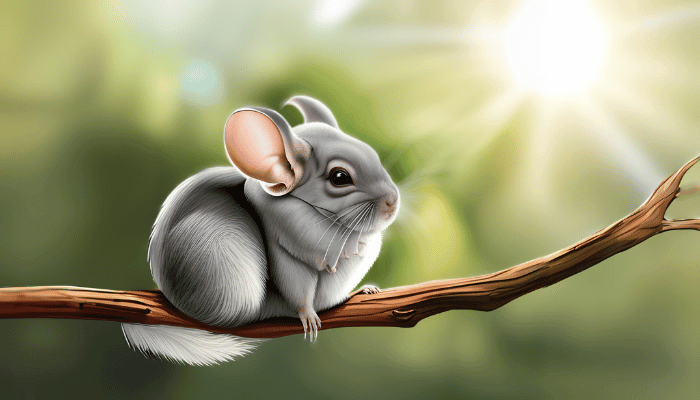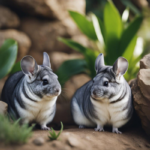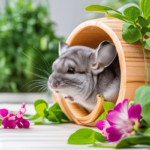If you’ve ever been enchanted by the adorable antics of chinchillas and decided to bring these lively creatures into your home, you’ve made a fantastic choice. Chinchillas make delightful pets, but providing them with a comfortable and secure habitat is crucial for their well-being.

In this comprehensive guide, we’ll explore the art of building chinchilla cages – creating a haven where your furry friends can thrive.
Understanding Chinchilla Behavior
Chinchillas are notorious chewers, jumpers, and climbers. They need room to explore and express their natural behaviours. When building chinchilla cages, keep in mind that vertical space is just as crucial as horizontal.
The Basics of Building Chinchilla Cages

What Makes a Good Chinchilla Cage?
Building a chinchilla cage isn’t just about enclosing your pet; it’s about creating a haven that mimics their natural habitat. A good chinchilla cage provides ample space for movement, separate areas for play and rest, and opportunities for mental stimulation.
Let’s kick off our journey by understanding the fundamental elements of constructing a chinchilla cage.
Cage Material Matters
When you embark on the adventure of building chinchilla cages, the first consideration is the choice of materials. Opt for non-toxic, chew-proof options like galvanized steel, as chinchillas have a penchant for nibbling on anything in their vicinity.
Selecting the Right Cage Size
Ever heard the phrase “size matters”? Well, in the chinchilla world, it certainly does. A spacious cage allows for ample exercise and exploration. Aim for dimensions that exceed the minimum requirements to keep your furry friend happy and healthy.
Chinchillas thrive in spacious environments. A minimum cage size of 24″ x 24″ x 24″ is recommended. However, the more extensive, the better.
Ventilation and Airflow
Proper ventilation is essential. When building chinchilla cages, ensure there are well-ventilated areas to prevent respiratory issues. Good airflow is crucial for maintaining a healthy environment.
DIY Chinchilla Cage Plans

Now, let’s get our hands dirty and explore some DIY plans for building chinchilla cages.
The Condo Concept
Imagine a skyscraper for chinchillas. Build multi-level platforms within the cage, complete with ramps for an exciting vertical playground.
The Cozy Corner
Create a snug corner using natural wood, offering a rustic retreat for your chinchilla to relax and unwind. Remember, comfort is key.
The Tunnel Haven
Chinchillas adore tunnels. Incorporate a labyrinth of PVC pipes into your design for a whimsical playground that stimulates their natural instincts.
Exploring Chinchilla Cage Aesthetics

Who says a chinchilla cage can’t be a stylish addition to your home? Let’s delve into the aesthetics of your furry friend’s abode.
Color Palette Play
Chinchillas are sensitive to light, so opt for neutral colors to create a soothing environment. Think earthy tones and muted hues for a visually appealing cage.
Decor Drama
Spruce up the cage with safe, chewable decorations. Wooden toys, hanging accessories, and soft bedding not only entertain but also add a touch of flair.
The Zen Zone
Create a serene corner with a dust bath. Chinchillas love to roll around in dust to maintain their luxurious fur, and it adds a zen-like element to their space.
Maintaining the Chinchilla Castle

Building a chinchilla cage is just the beginning; maintenance is the key to a happy and healthy cohabitation.
Regular Cleaning Rituals
Chinchillas are meticulous groomers, and they prefer a clean environment. Schedule regular cage cleaning sessions to keep both you and your pet content.
Health Checks
Keep an eye on your chinchilla’s health. Look for signs of stress, check their teeth, and monitor their activity levels. A happy chinchilla is a healthy chinchilla.
Decorating Your Chinchilla’s Paradise

Bedding Bliss: Choosing the Right Substrate
Chinchillas love to burrow and dig, so bedding choice matters. Opt for dust-free options like hay or aspen shavings. It’s like giving your chinchilla a soft, cozy mattress.
Toys Galore: Keeping Your Chinchilla Entertained
Enrichment is key to a happy chinchilla. Introduce toys like wooden blocks and chew toys to keep them mentally stimulated. It’s like hosting a perpetual chinchilla carnival!
DIY Chinchilla Cages: Crafting Your Masterpiece

Materials Needed for a DIY Cage
Before embarking on your DIY journey, gather the following materials:
- Sturdy wire mesh
- Metal connectors
- Plywood or plastic for the base
- Chinchilla-safe paint or sealant
Step-by-Step DIY Cage Construction
Frame Construction
- Begin by constructing a sturdy frame using the wire mesh and connectors.
- Ensure all edges are secure to prevent any injuries.
Base Creation
- Design a solid base using plywood or plastic.
- Apply a chinchilla-safe sealant to protect against urine and moisture.
Levels and Platforms
- Add platforms and ramps to create an engaging, multi-level environment.
- Ensure platforms are stable and securely attached.
Doors and Access Points
- Include large, easy-to-open doors for accessibility during cleaning.
- Use secure latches to prevent accidental escapes.

Chinchilla-Approved Accessories
Enrich your chinchilla’s habitat with accessories like wooden ledges, hanging toys, and dust baths for their grooming needs.
Maintaining a Clean Chinchilla Habitat
Chinchillas are meticulous groomers, but their cages still require regular cleaning. Develop a cleaning routine to ensure your pet’s living space remains hygienic.
Addressing Chinchilla Safety Concerns
Regularly inspect the cage for any potential hazards, such as sharp edges or loose wires. Remove any items that could pose a risk to your furry friend.
Conclusion
In the realm of building chinchilla cages, the key is to strike a balance between functionality and fun. Your chinchilla’s happiness depends on a well-designed, safe, and stimulating environment.
Whether you opt for a ready-made cage or embark on a DIY adventure, always prioritize your furry friend’s well-being. Crafting a chinchilla paradise is not just about a cage; it’s about creating a home where joy and comfort intertwine.
Building Chinchilla Cages: FAQs

Can I use plastic materials in building chinchilla cages?
It’s best to avoid plastic materials, as chinchillas may chew on them, leading to potential health issues. Stick to wood and metal for a safe environment.
How large should the chinchilla cage be?
The bigger, the better. Aim for a spacious cage to accommodate their active lifestyle. A minimum of 3 feet by 2 feet by 2 feet is a good starting point.
What flooring is suitable for chinchilla cages?
Solid flooring is preferable. Avoid wire flooring, as it can be harsh on their delicate feet. Cover the floor with fleece or a similar material for comfort.
Can chinchillas be housed together?
Chinchillas are social but can be territorial. It’s recommended to house them separately to prevent conflicts.
How often should I clean the chinchilla cage?
Regular cleaning is essential. Remove droppings daily and perform a deep clean at least once a week to maintain a hygienic environment.
Are wire-bottom cages suitable for chinchillas?
No, wire bottoms can cause foot injuries. Opt for a solid surface or cover the wire with a safe material like fleece.
What bedding is ideal for chinchillas?
Choose dust-free bedding like aspen shavings or fleece to ensure your chinchilla’s comfort.
Can I use recycled materials for building the cage?
While recycling is noble, prioritize safety. Ensure any recycled materials are thoroughly cleaned and non-toxic.
Can I use a glass aquarium as a chinchilla cage?
While aquariums may seem secure, they lack proper ventilation. Chinchillas are prone to overheating, so it’s best to stick with well-ventilated wire cages.
Are multi-level cages suitable for chinchillas?
Absolutely! Chinchillas love to climb and explore. Multi-level cages with ramps and platforms provide the ideal environment for their active nature.
What should I include in a chinchilla’s play area?
A chinchilla’s play area should have safe toys, tunnels, and a dust bath. Create a stimulating space to cater to their curious and playful instincts.











2 thoughts on “Mastering the Art of Building Chinchilla Cages: A DIY Guide”